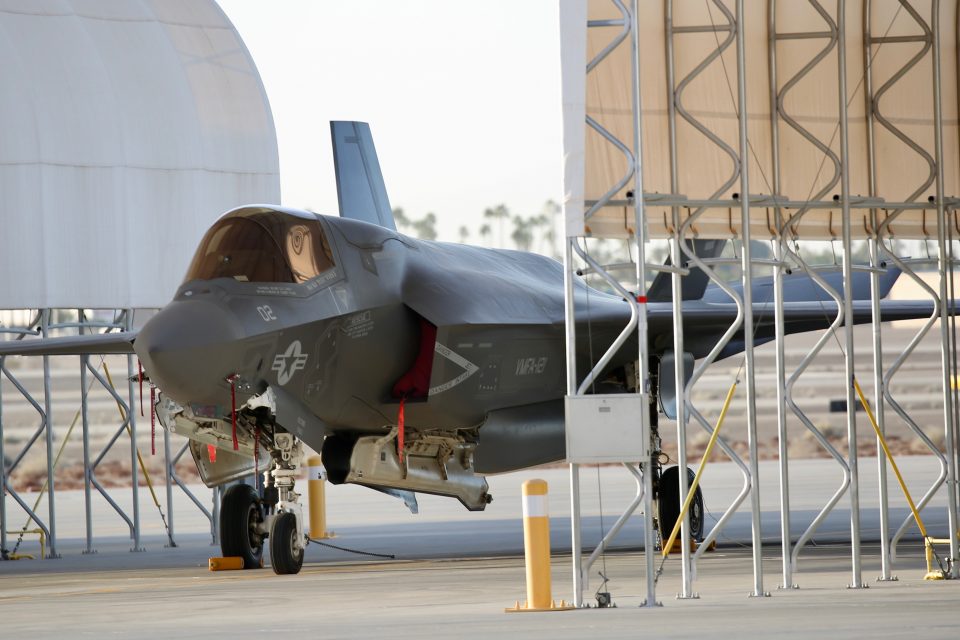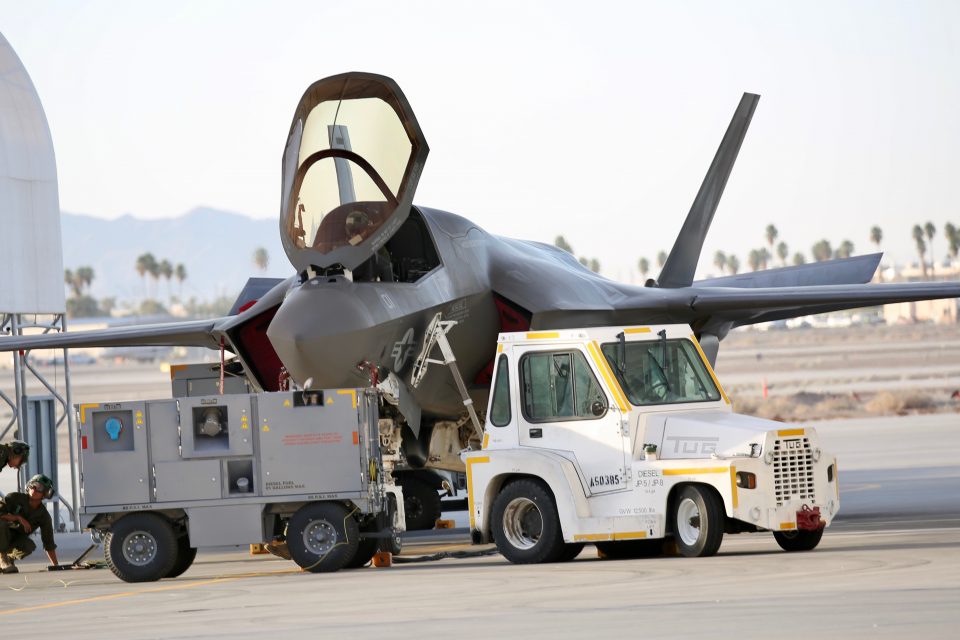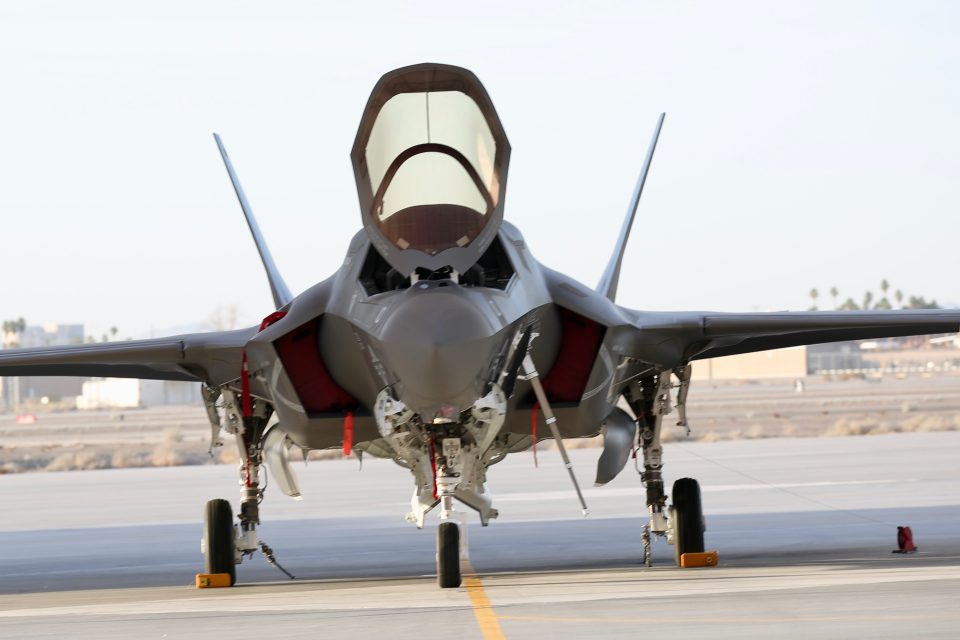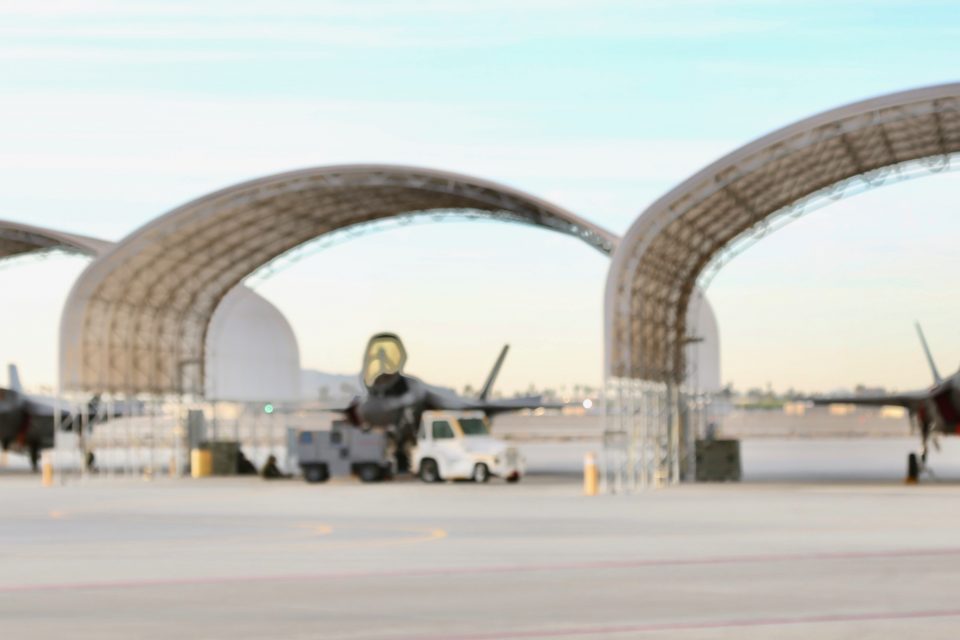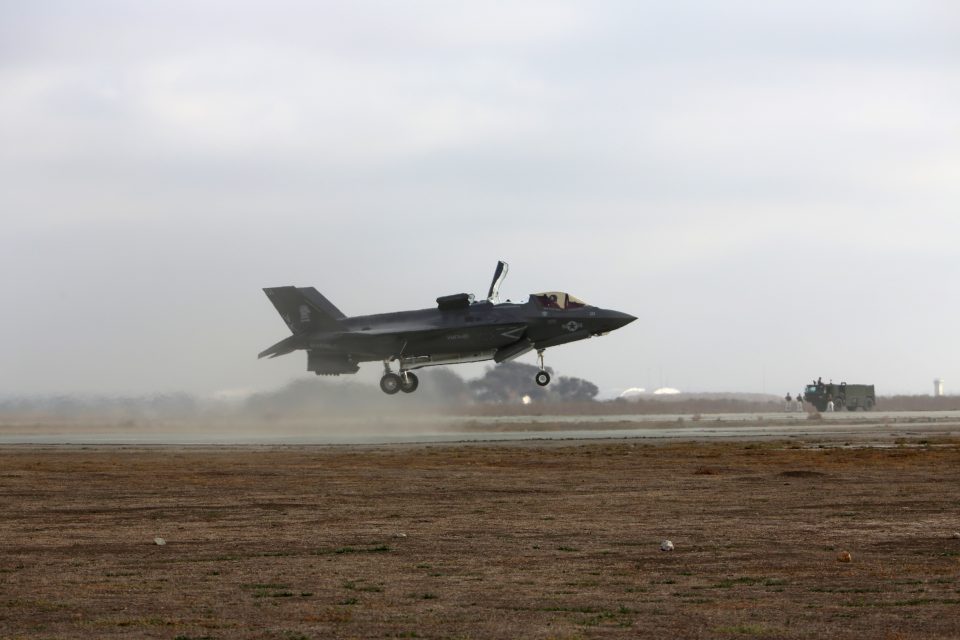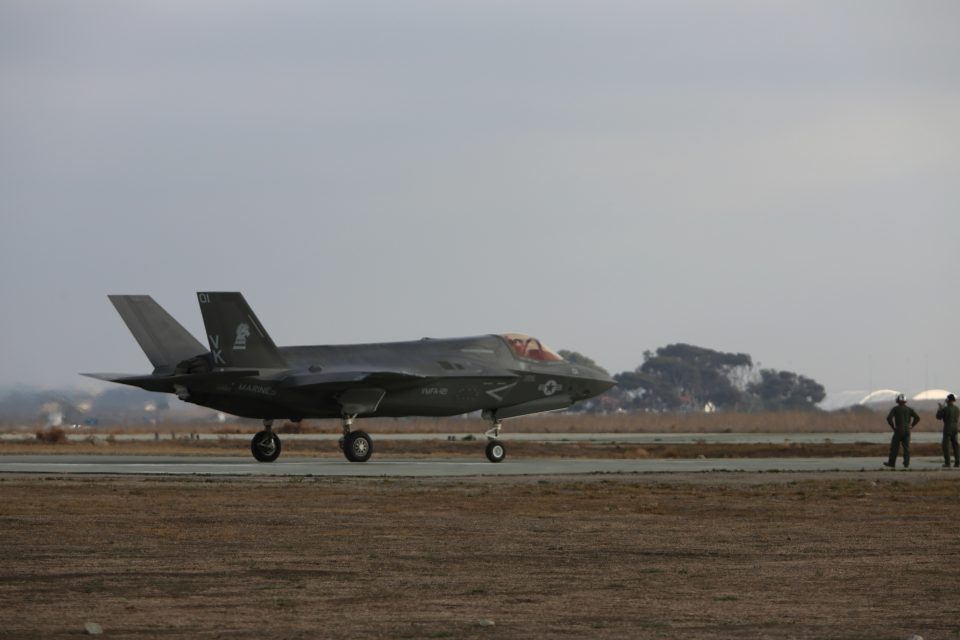09/10/2017: On August 20, 1942, the first allied air units, to include 1st Marine Aircraft Wing, landed at Guadalcanal. They became known as the “Cactus Air Force,” one of the most innovative, hybrid units of WWII.
By September 11th, 1,014 aviation personnel were operating on Guadalcanal. Of these, 33 were Army, 64 Navy and 917 were Marines.
The battle of Guadalcanal would become the defining point for Marine Corps aviation in WWII and for the next fifty years.
Brig. Gen. Thomas D. Weidley, 1st MAW commanding general, speaks about their role during the battle of Guadalcanal.
OKINAWA, JAPAN:09.02.2017
Video by Sgt. Laura Gauna
III Marine Expeditionary Force
2017-01-02 By Ed Timperlake and Robbin Laird
We last visited VMF-121 prior it being declared IOC with the F-35B.
That visit was in the Summer of 2014 and we spent time the then XO of the Squadron, Major Summa, now Lt. Col. Summa and the CO of the Beaufort Squadron of F-35s, namely the Warlords of Marine Fighter Attack Training Squadron 501, which we have also visited.
http://sldinfo.wpstage.net/visiting-mcas-beaufort-air-station-f-35b-and-renorming-airpower/
During our most recent visit to MCAS Yuma we had a chance to visit both of the IOC F-35B squadrons in Marine Aircraft Group-13.

We also visited with MAWTS-1 and VMX-1, who have just returned from DT-III testing onboard the USS America.
The first F-35B IOC squadron in the world, VMF-121, the Green Knights, are in the processing of transitioning to their deployment in Japan.
Equipment and personnel are already on the way to Japan and the squadron will fly out this winter across the Northern Pacific to operate from Japan.
The deployment comes at a crucial time, given ongoing developments in the Pacific, and the opportunity to be combat operational with F-22s in Pacific Defense.
The F-35B will continue with this new generation of a V/STOL aircraft to work its flexibility with regard to ships and landing bases, which do not necessarily have to be regular airfields.
The flexibility which the B provides is an inherent advantage in the Pacific, with its rich tapestry of islands from which to operate to have the unique “F/A/E -35B” integrate into the emerging Kill Webs as expressed by Rear Admiral Manzer.
http://breakingdefense.com/2016/10/rear-adm-manazir-speaks-on-allied-force-transformation-a2ad/
We had a chance to talk with Lt. Col. Bardo, the CO of the squadron, who is taking the squadron to Japan but will soon thereafter transition from the squadron.
But Bardo has been with the squadron during its IOC and work up with the Marine Corps for its deployment to Japan.
He and his squadron are performing key historical tasks as the cutting edge operational F-35 squadron in the world.
This is an unusual situation for the Marines to find themselves in terms of combat air, but the flexibility of a combat information dominance aircraft fits right in with the evolving concepts of operations of the Marines.
Lt. Col. Bardo underscored the importance of Close Air Support for Marines and the role which the F-35 can play in significantly expanding the scope and nature of close air support.
“CAS is considered doctrinally a function which operates only in a permissive air environment.
We can expand CAS to deal with a much wider range of situations than when we would simply operate in a permissive air environment.
And we can provide greater assurance to Marines as they deploy on the ground that we can deal with a much wider array of pop-up threats than we could do with legacy aircraft.”
Lt. Col. Bardo described the path to get to where the squadron was right now as it prepared for its Japanese deployment.
The period since declaring IOC has been a busy and challenging one as the squadron pushed out the boundaries of the operational capabilities of the aircraft and worked with MAGTF to integrate the airplane into the CAS role as well as working with the USAF on the air to air missions as well.
It has been a busy period for Bardo and his squadron but certainly historic as well.
Throughout the squadron has found the core capabilities of the aircraft to be a solid foundation for shaping the way ahead.
As Lt. Col Bardo described the F-35:
“For the pilot, the ability to shift among missions without having to think sequentially about doing so is really a key strength of the aircraft.
The airplane can think CAS and air-to-air at the same time and the pilot can then mix and match as the mission demands rather than having to think through the sequence of going from one mission set to the next.”
In broad terms, Lt. Col. Bardo described the progress of the squadron going from its time at 29 Palms working CAS, to working closely with MAWTS-1 on shaping the tactics for the use of the aircraft in support of the MAGTF, to its participation in Red Flag this summer as the F-35 component of the air operations being exercised at Red Flag.
In total, these experiences have been crucial in preparing the squadron for its deployment to Japan.
With regard to 29 Palms, the support to the ground combat element was the focus of attention in Steel Knight 2016, which included operating from Red Beach, an austere combat training facility where the presence of FOD or ground debris is a challenge.
http://sldinfo.wpstage.net/vmfa-121-at-red-beach/
http://sldinfo.wpstage.net/steel-knight-16-a-step-for-vmfa-121-on-the-way-to-japan-in-2017/
“At the exercise we could show Marines that the F-35 is a core asset for expanding the operational environment in which the MAGTF could operate and how we can support the GCE.
We built trust in the infantry in what this revolutionary STOVL asset can bring to the force and to enhance their lethality and survivability as well.”
With MAWTS-1, the squadron has worked closely on shaping the tactics and training for the new aircraft.
The MAWTS-1 F-35 instructors have come from VMF-121, and the synergy has been crucial to shaping the way ahead for VMF-121 as it faces its deployment to Japan.
Then this summer, the squadron sent planes to Red Flag and flew in a US-only exercise with the full panoply of USN and USAF aircraft, excluding the F-15s.
There the USMC flew its jets and were part of reshaping of air to air operations associated with the F-35.
Lt. Col. Bardo noted that there were many F-16 National Guard pilots who were there, some of which had flown with the F-22 but had not flown with the F-35.
They soon learned that you did not want to be an adversary but to leverage what the F-35 brought the fight.
As they prepared to the deployment to Japan the CO reflected back on his time with the squadron.
“It has been hard work and we have been at the cutting edge of many things with this new aircraft.
The squadron has met the challenges with hard work, innovation and courage and that is how we are preparing for our first overseas deployment, namely to Japan.”
We concluded by reflecting back over the history of the Green Knights who from the beginning brought innovation to the fight in the Pacific.
Historically it is interesting to note that VMF-121 was activated in June 1941 and began flying air ground combat missions in August 1942, with the “Cactus Air Force” on Guadalcanal.
The Green Knights made Marine aviation history with fourteen aces, including the legendary Joe Foss CMH so the F-35 enabled squadron is making its own aviation history.
Recently, the Vietnam generation “Green Knights: visited Yuma. Together with the F-35 generation Green Knights, the Vietnam generation Green Knights celebrated the USMC’s 241st birthday on November 19, 2016
Lt. Col. Bardo commented:
“It was amazing for us to meet with and discuss with the Vietnam-era Green Knights.
Although much has changed; much has not.
What I told the squadron with our visitors present: look at our predecessors and that will be you in a few years.
You want to be as proud as they are; to look back at your achievements as being the first F-35 squadron and making aviation history.
You will not focus so much on the hard work we have done over the past two years, but will focus on the achievements.
And learn from them about how to meet the challenges and serve the nation.”
Biography of Lt. Col. Bardo
Lieutenant Colonel Bardo is a graduate of Whittier College and holds a B.A. in Biology. He was commissioned a Second Lieutenant in May of 1998 and attended The Basic School that fall. Upon completion, he began Aviation Preflight training at NAS Pensacola, FL. He conducted his primary flight training in the T-34C while assigned to VT-28 at NAS Corpus Christi, TX. Following primary flight training, he was reassigned to VT-22 at NAS Kingsville, TX. He earned his Naval Aviator’s Wings in September of 2001.
He completed fleet replacement training in the AV-8B Harrier at Marine Attack Training Squadron 203 at MCAS Cherry Point, NC.
In September of 2002, First Lieutenant Bardo reported to MCAS Yuma and was assigned to Marine Attack Squadron 214.
While assigned to the “Black Sheep” he served as the Powerline Division Officer and a daily schedule writer. Promoted to Captain in October of 2002, he deployed in support of Operations Southern Watch (OSW) and Iraqi Freedom (OIF) I. In spring of 2004, Captain Bardo deployed aboard the USS Belleau Wood as part of the 11th Marine Expeditionary Unit (MEU). Upon reaching the Persian Gulf, the 11th MEU transitioned ashore in support of OIF II. Upon returning home from deployment, Captain Bardo transferred to 3D MAW headquarters in Miramar where he augmented the G-3 Staff while maintaining currency in the AV-8B.
In June of 2006, Captain Bardo returned to the “Black Sheep” and completed the flight leadership and instructor prerequisites to attend the Weapons and Tactics Instructor Course. Upon completion of WTI class 1-07 in October, Captain Bardo served as the Pilot Training Officer. In January 2007, he deployed to Japan for one year supporting two back-to-back 31st MEUs.
In October of 2008, he was promoted to Major and began serving as the Aircraft Maintenance Officer. He deployed in May 2009 to Kandahar Air Base, Afghanistan in support of Marine Aircraft Group 40, 2d Marine Expeditionary Brigade flying in support of Operation Enduring Freedom (OEF).
In December of 2009, Major Bardo reported to Eglin Air Force Base, FL as one of the initial cadre of instructors tasked with standing up the “Warlords” of Marine Fighter Attack Training Squadron 501, the USMC’s first F-35B squadron. In January of 2011, Major Bardo was selected to attend Intermediate Level School at the Naval War College in Newport, Rhode Island where he earned a Master of Arts in National Security and Strategic Studies. He returned to VMFAT-501 where he completed transition training to the F-35B. While at VMFAT-501, he served as the Director of Safety and Standardization as well as the Operations Officer.
In January of 2015, Lieutenant Colonel Bardo reported to MAG-13, located at MCAS Yuma, Arizona and assumed command of VMFA-121 in July of 2015.
Lieutenant Colonel Bardo has over 1800 flight hours, primarily in the AV-8B and F-35B and over 480 combat hours in support of OSW, OIF, and OEF. His qualifications include: Weapons and Tactics Instructor, Mission Commander, Training Landing Signal Officer, Air Combat Tactics Instructor, Low Altitude Tactics Instructor, Functional Check Flight pilot and Demonstration pilot.
His personal decorations include the Meritorious Service Medal, Air Medal with Strike Numeral “12”, Navy and Marine Corps Commendation Medal, third award, and Navy and Marine Corps Achievement Medal, fourth award.
http://www.3rdmaw.marines.mil/Leaders/LeadersView/Article/614148/lieutenant-colonel-bardo/
The first slideshow shows the squadron on the day we visited and are credited to Second Line of Defense.
The second slideshow shows the squadron participating in Steel Knight and operating at Red Beach.
The third slideshow shows them at Red Flag in an all-US air combat exercise.
The fourth slideshow shows a Japanese visit to the squadron in Yuma earlier this year with Lt. Col. Bardo working with the Japanese visitors.
The photos for the final three slideshows are all credited to the USMC.
Editor’s Note: When you visit the squadron, in the main building there is a Joseph Foss room.
Looking at the history of the squadron and Joe Foss’s role in that history, one can understand the heritage being built into the new combat capability represented by the F-35 B for the 21st Century USMC.
Tradition clearly matters.
Joseph Foss, C.O. VMF-121, Medal of Honor Recipient
By Stephen Sherman, July, 1999. Updated June 30, 2011.
Joe Foss was born on April 17, 1915 to a Norwegian-Scots family in South Dakota. He learned hunting and marksmanship at a young age. Like millions of others, 11-year old Joe Foss was inspired by Charles Lindbergh, especially after he saw Lindy at an airport near Sioux Falls.
Five years later he watched a Marine squadron put on a dazzling exhibition, led by Capt. Clayton Jerome, future wartime Director of Marine Corps Aviation.
In 1934, Joe began his college education in Sioux Falls, but he had to drop out to help his mother run the family farm. However he scraped up $65 for private flying lessons. Five years later he entered the University of South Dakota again and supported himself by waiting on tables. In his senior year he also completed a civilian pilot training program before he graduated with a Business degree in 1940.
Upon graduation he enlisted in the U.S. Marine Corps reserves as an aviation cadet. Seven months later, he earned his Marine wings at Pensacola and was commissioned a second lieutenant. For the next nine months he was a ‘plowback’ flight instructor. He was at Pensacola when the news of Pearl Harbor broke, and since he was Officer of the Day, he was placed in charge of base security. Thus he prepared to defend Pensacola from Jap invaders, riding around the perimeter on a bicycle.
To his distress, he was then ordered to the aerial photographers school and assigned to a VMO-1, a photo reconnaissance squadron.
But he insisted he wanted fighter pilot duty, even after being told “You’re too ancient, Joe. You’re 27 years old!” After lengthy lobbying with Aircraft Carrier Training Group, he learned all about the new F4F Wildcat, logging over 150 flight hours in June and July.
When he finished training, he became executive officer of VMF-121.
Three weeks later, he was on his way to the South Pacific, where the United States was desperately trying to turn the tide of war. Arriving in the South Pacific, VMF-121 was loaded aboard the escort carrier Copahee.
Guadalcanal
On the morning of October 9, they were catapulted off the decks, in Joe’s only combat carrier mission. Landing at Henderson Field, he was told that his fighters were now based at the ‘cow pasture.’
He was impressed with the ‘make-do’ character of the ‘Cactus Air Force. The airfield was riddled with bomb craters and wrecked aircraft, but also featured three batteries of 90mm anti-aircraft guns and two radar stations. As ‘exec’ of -121, he would normally lead a flight of two four-plane divisions, whenever there were enough Wildcats to go around.
He was the oldest pilot in the flight, four years older than the average age of 23. The flight would become known as ‘Foss’s Flying Circus’ and rack up over 60 victories. Five of them would become aces; two would die in the in the fight for Guadalcanal.
On October 13, 1942, VMF-121 scored its first victories when Lts. Freeman and Narr each got a Japanese plane. Later that same day, Joe led a dozen Wildcats to intercept 32 enemy bombers and fighters. In his first combat, a Zero bounced Joe, but overshot, and Joe was able to fire a good burst and claim one destroyed aircraft.
Instantly, three more Zeros set upon him, and he barely made it back to ‘Fighter One’, his Wildcat dripping oil. Chastened by the experience, he declared “You can call me ‘Swivel-Neck Joe’ from now on.” From the first day, Joe followed the tactics of Joe Bauer: getting in close, so close that another pilot joked that the ‘exec’ left powder burns on his targets. The next day while intercepting a flight of enemy bombers, Joe’s engine acted up and he took cover in the clouds. But suddenly a Wildcat whizzed past him, tailed by a Zero. Joe cut loose and shot the Zero’s wing off. It was his second victory in two days.
While the Wildcats’ primary responsibility was air defense, they also strafed Japanese infantry and ships when they had enough ammunition. Joe led on such mission on the 16th. Mid-October was the low point for the Americans in the struggle for Guadalcanal.
Japanese warships shelled the U.S. positions nightly, with special attention to the airstrips. To avoid the shelling, some fliers slept in the front lines. Foss grew to appreciate the Navy’s fighter doctrine and found that the “Thach Weave” effectively countered the Zero’s superior performance, because “it allowed us to point eyes and guns in every direction.”
Joe was leading an interception on morning of the 18th when the Zero top cover pounced on them and downed an F4F. But Foss was able to get above them and flamed the nearest, hit another, and briefly engaged a third. Gaining an angle, he finally shot up the third plane’s engine.

Next he found a group of Bettys already under attack by VF-71. He executed a firing pass from above, flashed through the enemy bombers, and pulled up sharply, blasting one from below. Nine days at Guadalcanal and he was an ace! Two days later Lt. Col. Harold Bauer and Foss led a flight of Wildcats on the morning intercept. In the dogfighting, Joe downed two Zeros, but took a hit in his engine. He landed safely at Henderson Field with a bad cut on his head, but otherwise unharmed.
‘Cactus Fighter Command’ struggled to keep enough Wildcats airworthy to meet the daily Japanese air strikes. On the 23rd, it put up two flights, led by Foss and Maj. Davis. There were plenty of targets and Joe soon exploded a Zero. He went after another which tried to twist away in a looping maneuver. Joe followed and opened up while inverted at the top of his loop. He caught the Zero and flamed it. He later described it as a lucky shot.
Next he spotted a Japanese pilot doing a slow roll; he fired as the Zero’s wings rolled through the vertical and saw the enemy pilot blown out of the cockpit, minus a parachute. Suddenly he was all alone and two Zeros hit him, but his rugged Grumman absorbed the damage, permitting Foss to flame one of his assailants.
Once again, he nursed a damaged fighter back to Guadalalcanal. So far he had destroyed eleven enemy planes, but had brought back four Wildcats that were too damaged to fly again.
October 25 was the day that the Japanese planned to occupy Henderson Field; they sent their fighters over, with orders to circle until the airstrip was theirs. It didn’t work out that way, as the U.S. ground forces held their lines and ‘Cactus’ did its part. Joe Foss led six Wildcats up before 10 AM, and claimed two of the Marine’s three kills on that sortie.
Afterwards, he berated himself for wasting ammunition on long-range shooting. He kept learning how important it was to get close. (The great German ace, Erich Hartmann, said “Get close enough until the airplane fills the whole windscreen; then you can’t miss.”) In an afternoon mission on the 25th, he downed three more, to become the Marine Corps’ first ‘ace in a day’. He had achieved 14 victories in only 13 days.
Despite rugged living conditions and the stress of daily combat flying, Foss retained his enthusiasm. He and some other fliers of VMF-121 occasionally went prowling with their rifles in the jungle, looking for Japanese soldiers, but Col. Bauer stopped this activity; trained fighter pilots were too valuable to risk this way.
They slept in six-man tents and ate the wretched powdered eggs that are mentioned in almost every pilot’s memoirs. On guy had a gramophone that they played scratchy records on. They bathed in the Lunga River; many grew beards rather than try to shave in cold water. They kept the beards neatly trimmed, not for appearances, but to ensure their beards didn’t interfere with the close-fitting oxygen masks. ‘Washing Machine Charlie’ and ‘Millimeter Mike’ harassed the field nightly, so some pilots tried to sleep in the daytime.
Down!
On November 7th Foss led seven F4Fs up the Slot to attack some IJN destroyers and a cruiser, covered by six Rufe floatplane fighters. They dispatched five of the Rufes promptly and prepared to strafe the destroyers. Joe climbed up to protect the others and got involved in a dogfight with a Pete, a two-man float biplane. He shot down the slow-flying plane, but not before its rear gunner perforated the Wildcat’s engine with 7.7mm machine gun fire.
Once again, Foss’ aircraft started sputtering on the way home. But his time, it didn’t make it. As the engine died, he put it into the longest possible shallow dive, to get as close to home as he could.
As his plane went into the water off Malaita Island, Foss struggled with his parachute harness and his seat. He went under with his plane, gulped salt water, and almost drowned before he freed himself and inflated his Mae West. Exhausted and with the tide against him, he knew that he couldn’t swim to shore. While trying to rest and re-gain his strength in his life raft, he spotted shark fins nearby. He sprinkled the chlorine powder supplied for that purpose in his emergency pack and that seemed to help.
As darkness approached, he heard some searchers looking for him. They hauled him in and brought him to Malaita’s Catholic mission. There were a number of Europeans and Australians, including two nuns who had been there for forty years and had never seen an automobile. They fed him steak and eggs and invited him stay for two weeks.
The next day a PBY Catalina, piloted by Maj. Jack Cram rescued him. On his return to Guadalcanal, he learned that ‘Cactus’ had downed 15 Japanese planes in the previous day’s air battle. His own tally stood at 19. On the ninth, Admiral Bull Halsey pinned the Distinguished Flying Cross on him and two other pilots.
The Americans were bringing four transports full of infantry to Guadalcanal on November 12. The Japanese sent 16 Betty bombers and 30 covering Zeroes after them, while the American Wildcats and Airacobras defended.
Foss and his Wildcats were flying top cover CAP and dived headlong into the attackers, right down onto the deck. As Barrett Tillman described it in Wildcat Aces of WWII: Ignoring the peril, Foss hauled into within 100 yards of the nearest bomber and aimed at the starboard engine, which spouted flame. The G4M tried a water landing, caught a wingtip and tumbled into oblivion. Foss set his sight on another Betty when a Zero intervened. The F4F nosed up briefly and fired a beautifully aimed snapshot which sent the A6M spearing into the water. He then resumed the chase.

Foss caught up with the next Betty in line and made a deflection shot into its wingroot; the bomber flamed up and then set down in the water. The massive dogfight continued, until Joe ran out of fuel and ammunition.
Between the fighters and the AA, the Americans destroyed almost all the bombers and many of the Zeros. No U.S. ships were seriously damaged. But that night another naval surface battle raged in Ironbottom Sound. Warships on both sides were sunk or damaged, including the IJN battleship Hiei which Marine bombers and torpedo planes finished off on the 13th. The major Japanese effort continued on the 14th, as they brought in a seven ship troop convoy. The American air forces cut this up as well.
Late that afternoon, Col. Bauer, tired of being stuck on the ground at Fighter Command, went up with Joe to take a look. It was his last flight, described by Joe Foss in a letter to Bauer’s family. No trace of ‘Indian Joe’ was ever found. Back at Guadalcanal, Foss was diagnosed with malaria. Two great leaders of Cactus Fighter Command were gone, although Foss would return in six weeks.
He recuperated in New Caledonia and Australia. He met some of the high-scoring Australian aces, who viewed the Japanese as inferior opponents and were a little dismissive of Joe’s 23 victories. After a brief relapse of malaria, Joe returned to Guadalcanal on New Year’s Day. Improvements had been made in his absence, notably pierced steel planking (PSP) for the Fighter Strip. Foss returned to combat flying on the 15th when he shot down three more planes to bring his total to 26.
He flew his last mission ten days later when his flight and four P-38s intercepted a force of over 60 Zeros and Vals. Quickly analyzing the situation, he ordered his flight to stay high, circling in a Lufbery. This made his small flight look like a decoy to the Japanese. Soon Cactus scrambled more fighters and the Japanese planes fled. It was ironic that in one of Joe Foss’ most satisfying missions, he didn’t fire a shot.
http://acepilots.com/usmc_foss.html



